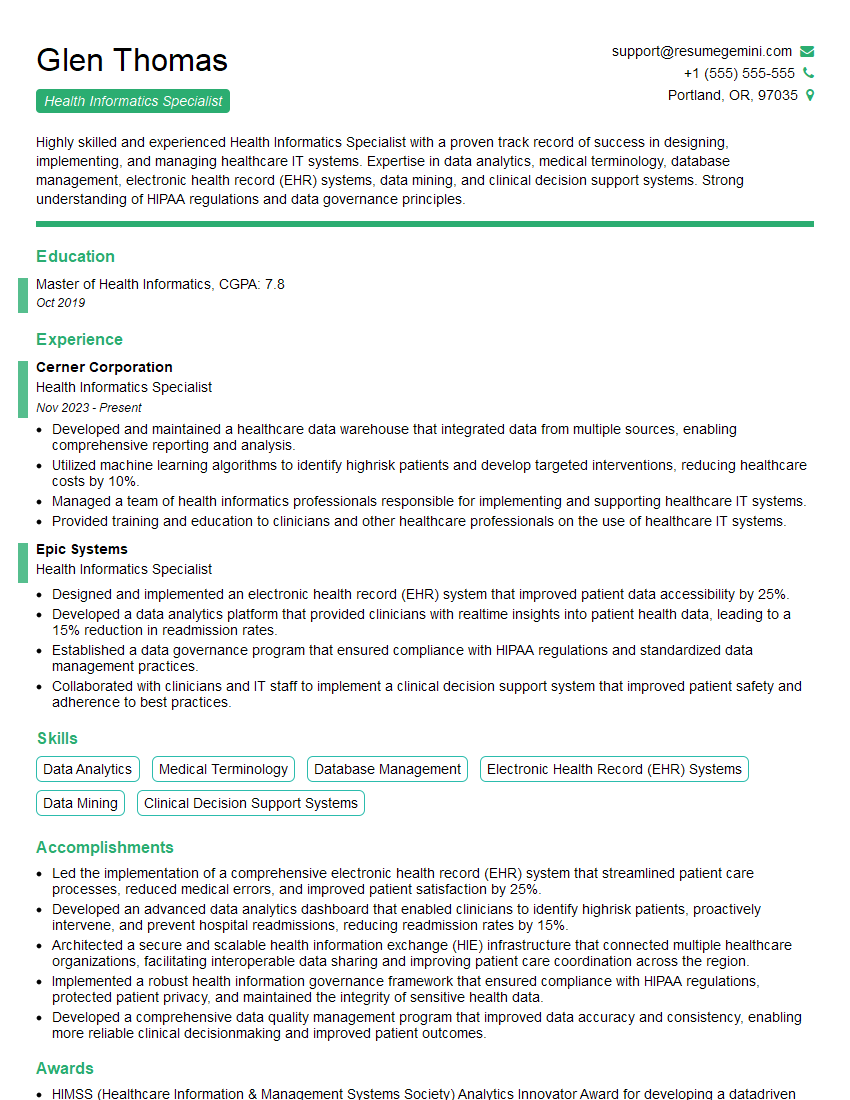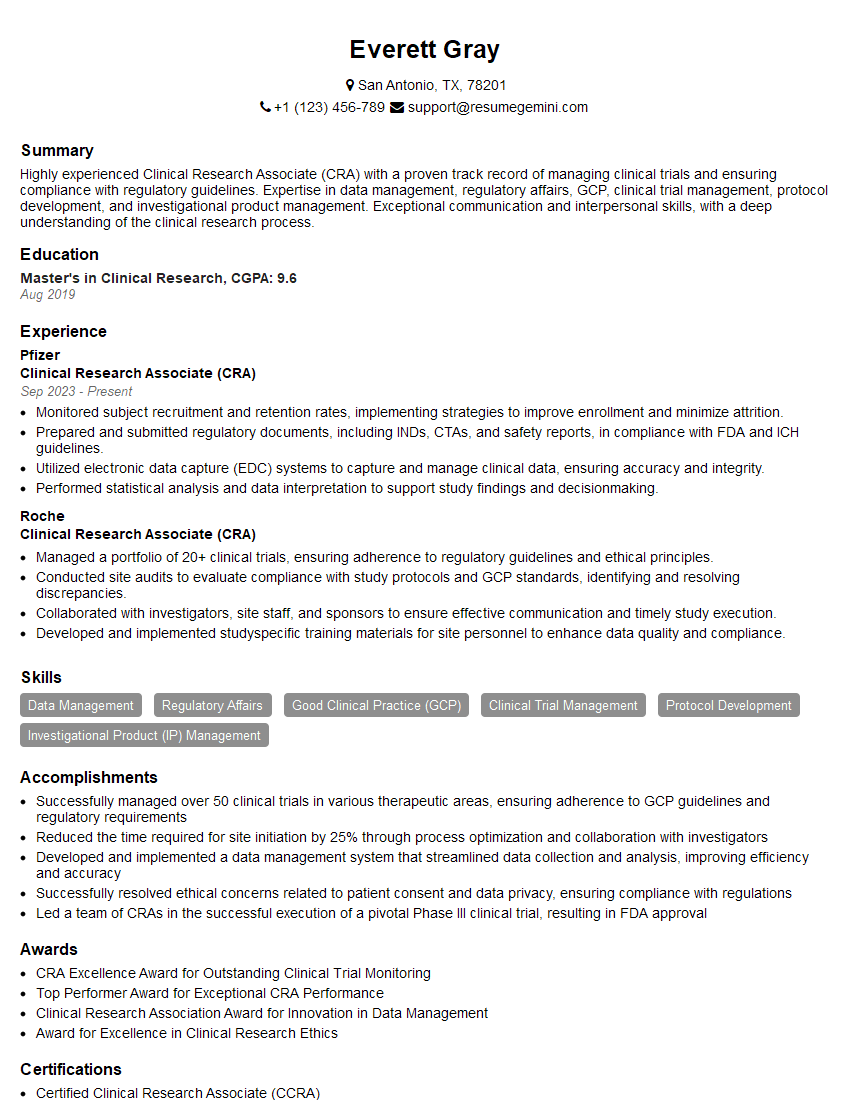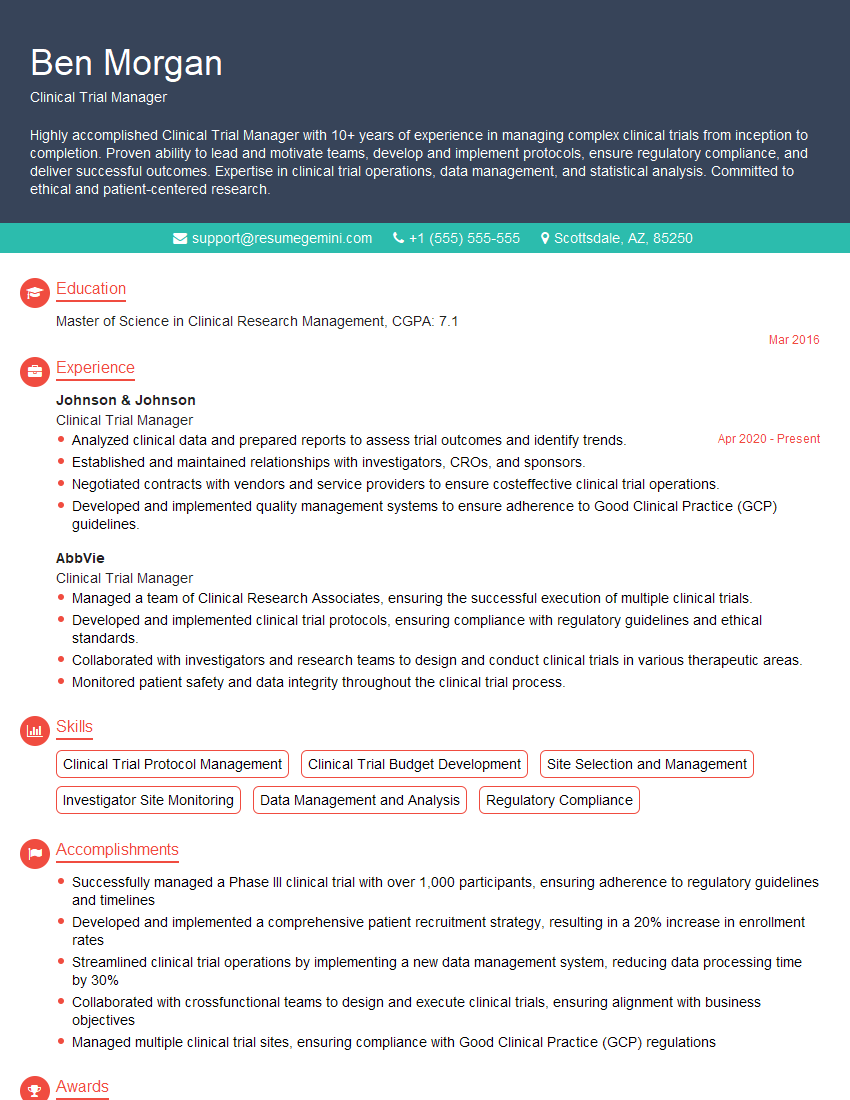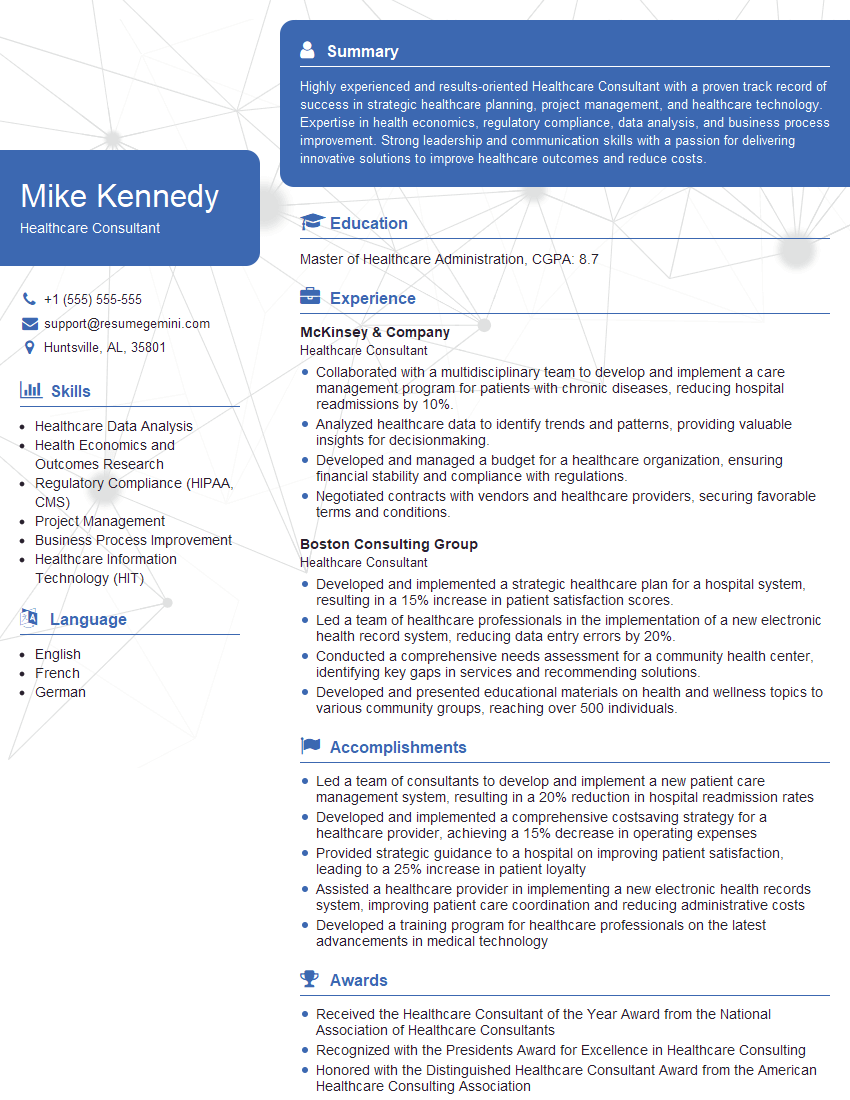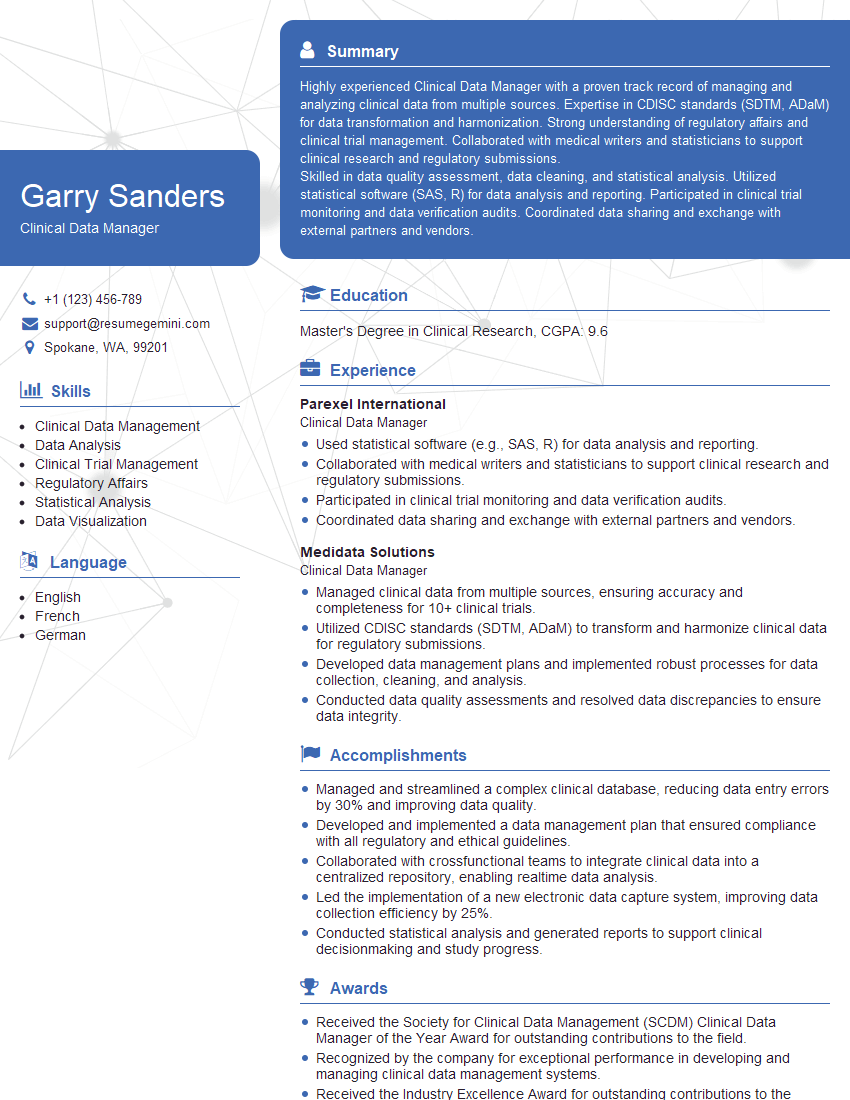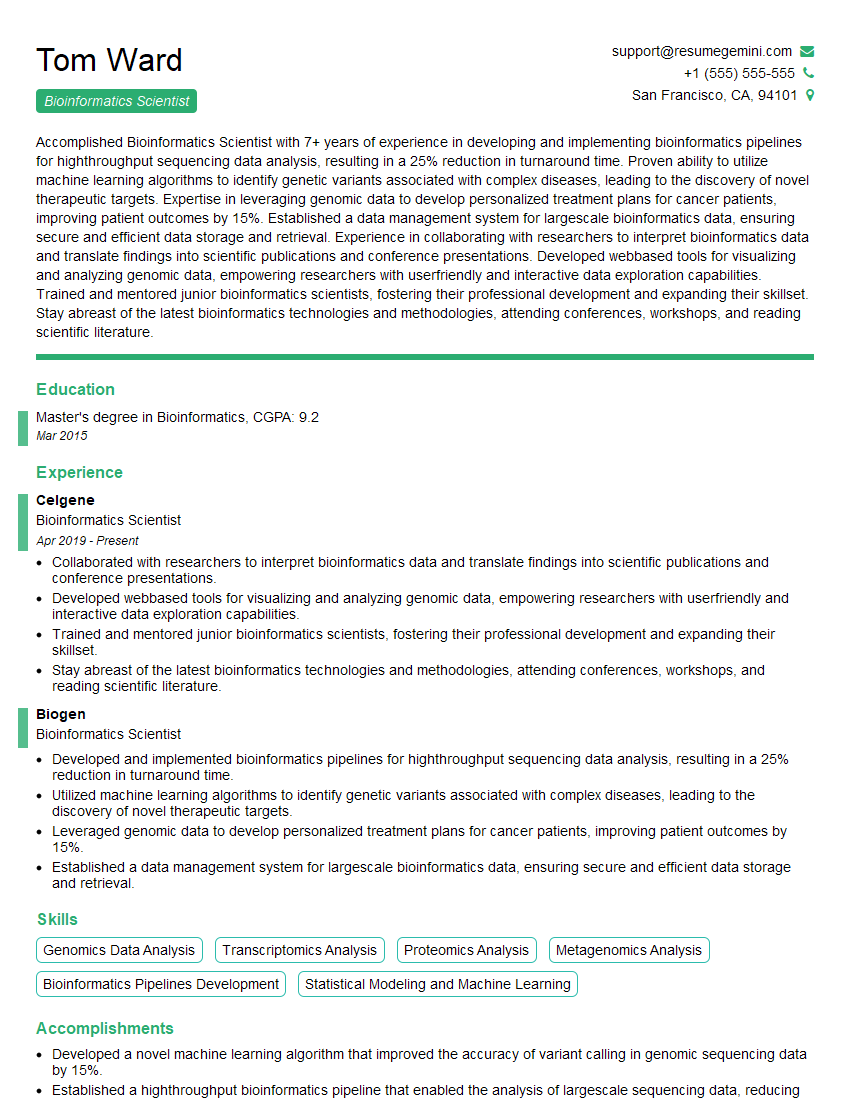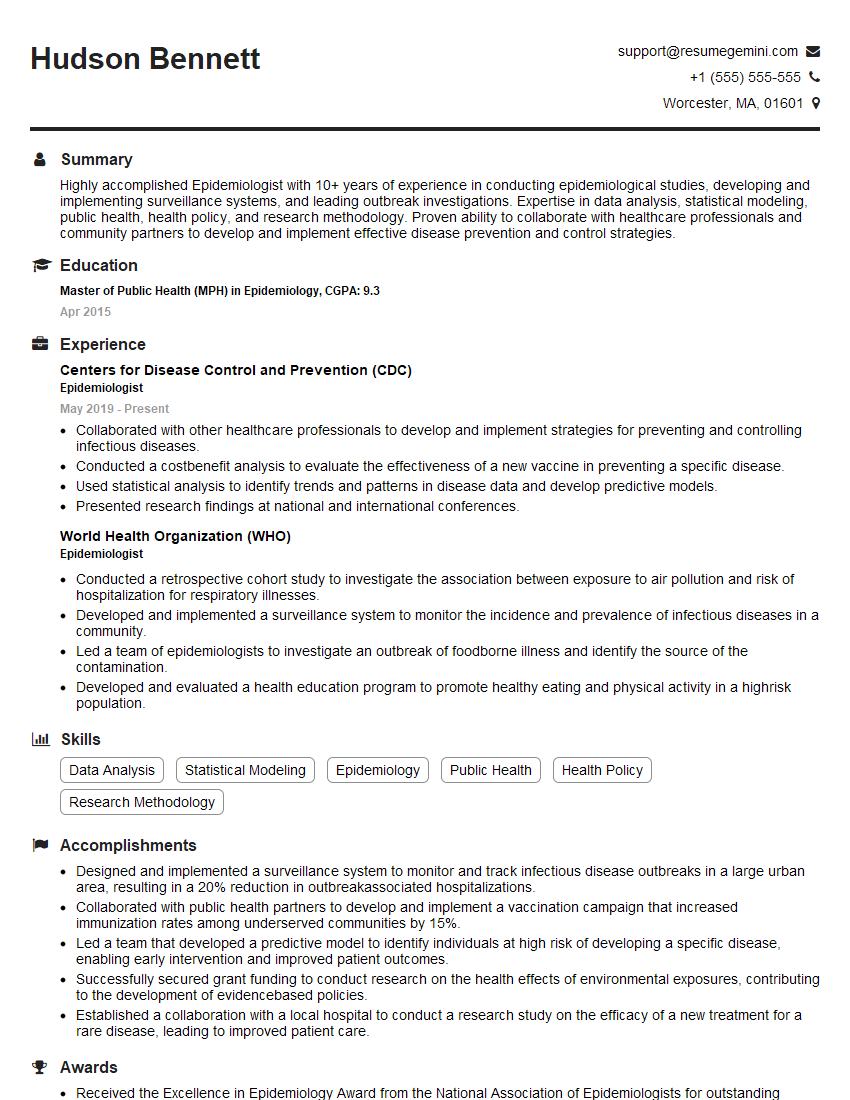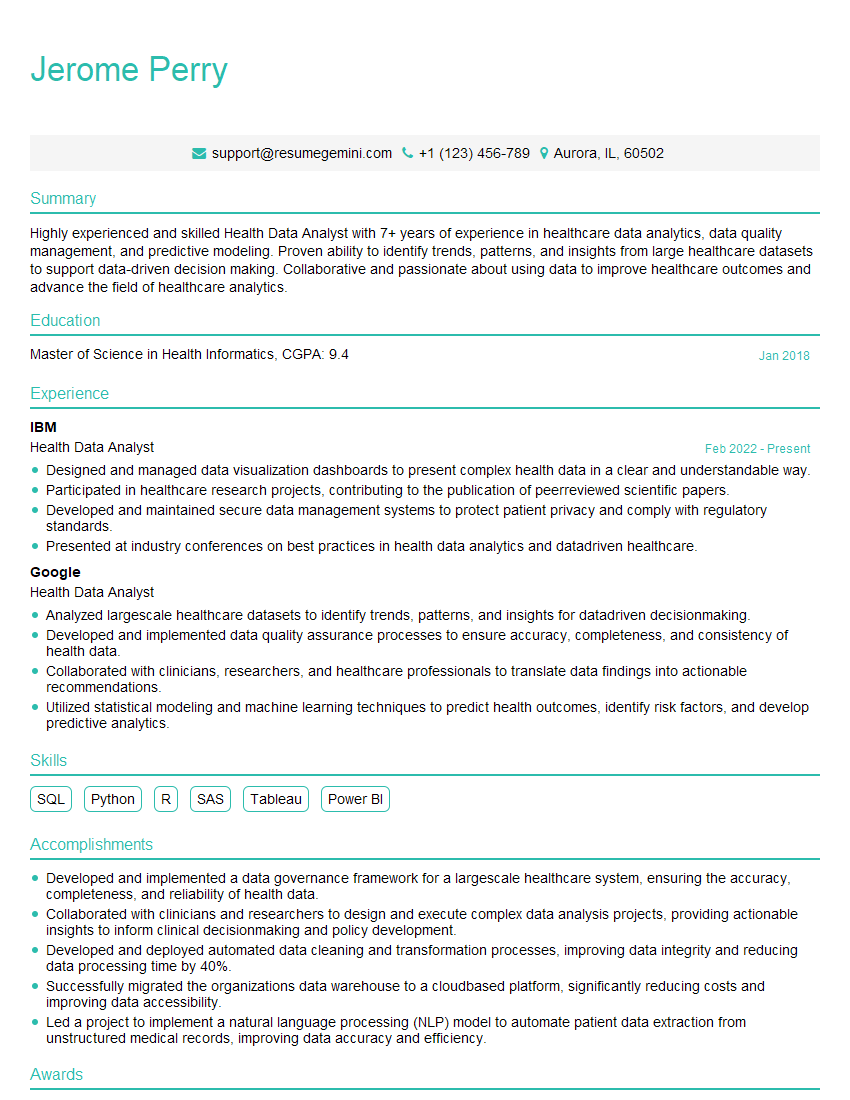Interviews are more than just a Q&A session—they’re a chance to prove your worth. This blog dives into essential Interpretation of Clinical Data interview questions and expert tips to help you align your answers with what hiring managers are looking for. Start preparing to shine!
Questions Asked in Interpretation of Clinical Data Interview
Q 1. Explain the difference between descriptive and inferential statistics in clinical data analysis.
Descriptive statistics summarize and describe the main features of a dataset, while inferential statistics use sample data to make inferences about a larger population. Think of it like this: descriptive statistics tell you what is happening in your data, while inferential statistics help you understand why it’s happening and whether your findings are generalizable.
For example, in a clinical trial comparing two blood pressure medications, descriptive statistics might tell us the average blood pressure for each group, the range, and the standard deviation. Inferential statistics, however, would allow us to determine if there’s a statistically significant difference in blood pressure reduction between the two groups, and to estimate the effect size of the treatment.
- Descriptive Statistics: Includes measures like mean, median, mode, standard deviation, range, percentiles, and frequency distributions. They provide a snapshot of the data.
- Inferential Statistics: Includes techniques like hypothesis testing (t-tests, ANOVA, chi-square tests), confidence intervals, regression analysis, and more. They draw conclusions about the population based on sample data.
Q 2. Describe your experience with different types of clinical data (e.g., continuous, categorical, binary).
My experience encompasses a wide range of clinical data types. I’m proficient in handling:
- Continuous data: This represents measurements on a continuous scale, such as height, weight, blood pressure, or lab values (e.g., cholesterol levels). I’m comfortable using various statistical techniques to analyze continuous data, including t-tests, ANOVA, and regression analysis.
- Categorical data: This represents data that can be grouped into categories, such as gender (male/female), race, or disease type. Chi-square tests and Fisher’s exact tests are common tools I use for analyzing categorical data.
- Binary data: A special case of categorical data, where there are only two possible outcomes (e.g., success/failure, presence/absence of a disease). Logistic regression is a powerful technique for analyzing the relationship between predictor variables and a binary outcome.
In my previous role, I worked extensively with electronic health records (EHR) data, which often includes a mix of these data types. This required me to be adept at data cleaning, transformation, and the appropriate selection of statistical methods based on the characteristics of the data.
Q 3. How do you handle missing data in a clinical dataset?
Missing data is a common challenge in clinical research. The optimal approach depends on the extent and pattern of missingness. Ignoring missing data can bias results, so careful consideration is crucial.
- Understanding the mechanism of missingness: Is it Missing Completely at Random (MCAR), Missing at Random (MAR), or Missing Not at Random (MNAR)? This significantly influences the chosen strategy.
- Imputation techniques: If the missing data is MCAR or MAR, I might use imputation methods to fill in the missing values. Common methods include mean/median imputation (simple but potentially biased), multiple imputation (more sophisticated and generally preferred), and k-nearest neighbor imputation.
- Analysis methods that accommodate missing data: For certain analyses, particularly with a small amount of missing data, techniques like multiple imputation are preferable to single imputation because they account for uncertainty in imputed values. Alternatively, some statistical models can directly handle missing data, such as maximum likelihood estimation.
- Sensitivity analysis: Regardless of the imputation strategy used, it’s crucial to conduct a sensitivity analysis to assess how different assumptions about the missing data mechanism affect the results.
For example, in a study on diabetes, if many patients with severe complications dropped out, it might bias the results. Proper handling of missing data would require investigating the reason behind missing data and using appropriate imputation or analysis methods to account for this.
Q 4. What statistical methods are you familiar with for analyzing clinical trial data?
My experience with analyzing clinical trial data includes a broad range of statistical methods, depending on the study design and research question. These include:
- t-tests and ANOVA: For comparing means between two or more groups.
- Chi-square and Fisher’s exact tests: For comparing proportions or frequencies.
- Regression analysis (linear, logistic, Cox proportional hazards): To examine relationships between variables and predict outcomes. Linear regression is used for continuous outcomes, logistic regression for binary outcomes, and Cox proportional hazards for time-to-event data (survival analysis).
- Survival analysis (Kaplan-Meier curves, Cox regression): To analyze time-to-event data, such as time until disease progression or death.
- Mixed-effects models: To account for correlations within subjects or clusters in longitudinal studies.
I’m also familiar with the intricacies of analyzing data from randomized controlled trials (RCTs), including intention-to-treat and per-protocol analyses, and the importance of adjusting for confounding variables.
Q 5. How do you identify and address outliers in clinical data?
Outliers in clinical data can significantly skew results and need careful consideration. Identification typically involves visual inspection of data distributions (histograms, boxplots) and statistical methods.
- Visual inspection: Plotting data helps identify points far from the majority of data points.
- Statistical methods: The interquartile range (IQR) method is frequently used. Values beyond 1.5 times the IQR below the first quartile or above the third quartile are considered potential outliers. Other methods include Z-scores (values beyond a certain number of standard deviations from the mean) and robust methods that are less sensitive to outliers.
- Investigating outliers: Once identified, don’t automatically discard them. Investigate the reasons behind them. Were there errors in data entry or measurement? Do they represent a genuine phenomenon or a true exceptional case?
- Handling outliers: Options include removal (only if justifiable), transformation (e.g., logarithmic transformation), or use of robust statistical methods that are less sensitive to outliers (e.g., median instead of mean, robust regression).
For example, an unusually high blood pressure reading might be due to an error, but it could also indicate a serious condition. Careful investigation is crucial before deciding how to handle such an outlier.
Q 6. Explain your understanding of p-values and their limitations.
The p-value is the probability of observing results as extreme as, or more extreme than, the results actually obtained, assuming the null hypothesis is true. A small p-value (typically less than 0.05) is often interpreted as evidence against the null hypothesis. However, p-values have limitations:
- Doesn’t indicate the size of the effect: A small p-value doesn’t necessarily mean a large or clinically important effect. A large sample size can lead to a statistically significant result even with a small effect size.
- Prone to misinterpretation: It’s crucial to consider the context and the effect size, not just the p-value. Focusing solely on significance testing can lead to misleading conclusions.
- Affected by sample size: Larger sample sizes tend to yield smaller p-values, even for small effects.
- Doesn’t measure the probability that the null hypothesis is true: It measures the probability of observing the data given the null hypothesis is true, not the other way around.
For instance, a p-value of 0.04 might suggest statistical significance but a small effect size might be clinically irrelevant. It’s essential to consider confidence intervals and effect sizes alongside the p-value for a complete understanding.
Q 7. What are the key considerations when interpreting confidence intervals?
Confidence intervals provide a range of plausible values for a population parameter (e.g., mean difference between groups). They are crucial for interpreting results alongside p-values.
- Width of the interval: A narrower confidence interval suggests more precise estimation of the parameter. A wider interval indicates greater uncertainty.
- Overlap with null value: If the confidence interval for a difference between groups includes zero (or the null value for the parameter), it suggests the observed difference isn’t statistically significant at the chosen level of confidence.
- Clinical significance: Even if a confidence interval doesn’t include the null value (and the p-value is small), the magnitude of the effect within the interval needs to be considered. Is the difference clinically meaningful?
- Confidence level: A 95% confidence interval means that if we repeated the study many times, 95% of the calculated intervals would contain the true population parameter. It doesn’t mean there’s a 95% probability that the true value lies within this specific interval.
For example, a 95% confidence interval for the difference in blood pressure between two groups might be (5 mmHg, 10 mmHg). This indicates that we are 95% confident that the true difference in blood pressure lies between 5 and 10 mmHg. This also suggests statistical significance because the interval does not contain zero.
Q 8. How do you assess the validity and reliability of clinical data sources?
Assessing the validity and reliability of clinical data sources is crucial for drawing accurate conclusions. Validity refers to whether the data accurately measures what it intends to measure, while reliability refers to the consistency and reproducibility of the measurements. We assess validity through several methods:
- Content Validity: Does the data capture all relevant aspects of the clinical phenomenon? For example, a depression scale should cover various symptoms, not just one aspect.
- Criterion Validity: Does the data correlate with a gold standard measure? This often involves comparing our data to an established, highly accurate method.
- Construct Validity: Does the data behave as expected based on theoretical understanding? For example, a new blood pressure measurement tool should show higher values in individuals with hypertension.
Reliability is assessed through:
- Test-Retest Reliability: Consistency of measurements over time. We’d expect similar results if we measure the same patient’s blood pressure multiple times in short succession.
- Inter-rater Reliability: Consistency of measurements across different assessors. Multiple clinicians should reach similar diagnoses using the same criteria.
- Internal Consistency Reliability: Consistency of items within a measurement instrument (like a questionnaire). This ensures all questions measure the same underlying construct.
In practice, we often use statistical methods like Cronbach’s alpha (for internal consistency) and correlation coefficients (for test-retest and criterion validity) to quantify these aspects. Data source credibility, including the reputation of the institution collecting the data and the methods used, also factors significantly into our assessment.
Q 9. Describe your experience with data visualization techniques for presenting clinical data.
Data visualization is key to effectively communicating clinical findings. My experience includes using a range of techniques, tailored to the specific data and audience. I’ve used:
- Bar charts and histograms: For displaying frequencies or distributions of categorical or continuous variables (e.g., number of patients with different disease stages).
- Scatter plots: To explore relationships between two continuous variables (e.g., correlation between age and blood pressure).
- Line graphs: To show trends over time (e.g., patient recovery progress).
- Box plots: To compare distributions across different groups (e.g., comparing blood sugar levels between treatment and control groups).
- Heatmaps: For visualizing correlation matrices or other multi-dimensional data (e.g., gene expression patterns).
For example, in a study evaluating a new drug’s efficacy, I would use a bar chart to compare the proportion of patients experiencing symptom improvement in the treatment and control arms. I would also use a Kaplan-Meier curve to visualize survival data and a boxplot to illustrate differences in key biomarkers between groups.
I always strive for clear, concise visualizations that avoid unnecessary complexity and accurately represent the data. Effective labeling, legends, and titles are essential for conveying the findings clearly and avoiding misinterpretations.
Q 10. How do you interpret Kaplan-Meier curves?
Kaplan-Meier curves are graphical representations of survival data over time. They illustrate the probability of an event (like death or disease recurrence) not occurring at a given time point. The curve starts at 100% survival at time zero and gradually decreases as events occur.
To interpret a Kaplan-Meier curve, consider the following:
- Overall survival: Look at the overall shape of the curve. A steeper curve indicates a higher event rate.
- Median survival time: The time point at which 50% of the subjects have experienced the event. This is a key summary measure.
- Confidence intervals: These intervals around the survival curve indicate the uncertainty in the estimated survival probabilities. Overlapping confidence intervals between groups suggest that the difference in survival may not be statistically significant.
- Comparison of groups: When multiple curves are displayed (e.g., for different treatment groups), the separation between the curves indicates the difference in survival probabilities. A larger separation suggests a greater treatment effect.
For instance, comparing two treatment arms for cancer, a Kaplan-Meier curve showing significantly better survival in one arm suggests that the treatment is more effective. Note that the visual interpretation should always be supplemented by appropriate statistical tests (e.g., the log-rank test) to determine if observed differences are statistically significant.
Q 11. Explain your understanding of ROC curves and AUC.
ROC (Receiver Operating Characteristic) curves are used to assess the diagnostic accuracy of a binary classifier. The curve plots the true positive rate (sensitivity) against the false positive rate (1-specificity) at various threshold settings. The Area Under the Curve (AUC) summarizes the ROC curve’s performance.
Interpreting ROC curves and AUC:
- ROC Curve Shape: A curve closer to the top-left corner indicates better diagnostic accuracy. A diagonal line represents random chance (no discriminatory power).
- AUC Value: The AUC ranges from 0 to 1. An AUC of 0.5 indicates no discrimination, while an AUC of 1 represents perfect discrimination. Generally, an AUC above 0.7 is considered acceptable for most clinical applications, while an AUC above 0.9 is excellent.
Example: In a study evaluating a new diagnostic test for a disease, an ROC curve with an AUC of 0.85 suggests that the test has good discriminatory power, meaning it can effectively distinguish between individuals with and without the disease. The ROC curve itself shows the trade-off between sensitivity and specificity at different threshold levels. A higher threshold increases specificity (fewer false positives) but reduces sensitivity (more false negatives), and vice-versa.
Q 12. How do you interpret hazard ratios?
Hazard ratios (HRs) quantify the relative risk of an event occurring in one group compared to another group over a specified period. They are often used in survival analysis, particularly in studies employing Cox proportional hazards models. A hazard ratio of 1 indicates no difference in risk between the groups. A hazard ratio greater than 1 means the event is more likely in the first group, while a hazard ratio less than 1 means the event is less likely.
Example: Let’s say a study comparing a new drug to a placebo shows a hazard ratio of 0.7 for cardiovascular events. This means that patients taking the new drug have a 30% lower risk of experiencing a cardiovascular event compared to those taking the placebo.
It is crucial to remember that hazard ratios are not risk differences. They represent the instantaneous relative risk at any given point in time, assuming the proportional hazards assumption of the Cox model holds true. The confidence interval around the hazard ratio should always be considered to assess the statistical significance of the finding.
Q 13. What are the common challenges in interpreting clinical data, and how do you overcome them?
Interpreting clinical data presents numerous challenges:
- Missing data: Missing values can bias results if not handled appropriately. Imputation techniques or sensitivity analyses can mitigate this.
- Data quality issues: Inconsistent data entry, errors, and outliers can affect the accuracy of the analysis. Data cleaning and validation are crucial.
- Confounding variables: Uncontrolled factors can influence the relationship between variables of interest. Statistical adjustments (e.g., regression analysis) can help address confounding.
- Small sample size: Limited sample sizes can reduce the statistical power of the analysis, making it difficult to detect meaningful effects. Careful study design and interpretation are crucial.
- Bias: Selection bias, measurement bias, and other types of bias can distort results. Rigorous study design, blinding, and appropriate statistical methods are necessary.
To overcome these challenges, I use a combination of approaches: thorough data cleaning and validation, appropriate statistical methods to handle missing data and confounding, robust study designs to minimize bias, and careful interpretation of results considering limitations of the data and study design. Visualization techniques also play a key role in identifying patterns and outliers.
Q 14. Describe your experience with different statistical software packages (e.g., SAS, R, SPSS).
I am proficient in several statistical software packages, including SAS, R, and SPSS. My experience encompasses a wide range of statistical analyses used in clinical data interpretation:
- SAS: I have extensively used SAS for large-scale data management, advanced statistical modeling (including survival analysis and generalized linear models), and reporting. Its strength lies in its robust handling of large datasets and its powerful procedures for complex analyses. For example, I used SAS to analyze a large clinical trial dataset to evaluate the efficacy of a new treatment.
- R: R is my preferred choice for exploratory data analysis and creating customized visualizations. Its flexibility and extensive package ecosystem enable advanced statistical modeling and data manipulation. I’ve used R to perform survival analysis, machine learning algorithms, and create publication-quality graphs. For example, I used R to build predictive models to identify high-risk patients.
- SPSS: SPSS is a user-friendly tool that I’ve used for descriptive statistics, basic statistical tests, and creating reports. Its strengths are ease of use and powerful features for managing and analyzing relatively small to medium datasets. I’ve used SPSS to perform simple statistical analyses and report findings.
My selection of software depends on the nature of the data, the complexity of the analysis, and the specific requirements of the project. I’m always keeping up-to-date on the latest developments in statistical software and methodologies to ensure I’m using the most appropriate and effective tools for each task.
Q 15. How do you ensure the quality and accuracy of your clinical data analysis?
Ensuring the quality and accuracy of clinical data analysis is paramount. It’s a multi-faceted process that begins even before data collection. We need to establish robust data governance from the outset, including well-defined data collection protocols, standardized data entry formats, and regular data quality checks.
Specifically, I employ several strategies:
- Data Validation: This involves checks for completeness, consistency, and plausibility. For example, I’d flag a patient’s age of 150 years as implausible. I use both automated checks (programmed rules within databases or statistical software) and manual reviews, particularly for complex or unusual data points.
- Source Verification: Tracing data back to its origin is crucial. This might involve reviewing original medical records or confirming information with healthcare providers to ensure accuracy.
- Statistical Methods: Employing appropriate statistical techniques, such as outlier detection and sensitivity analyses, helps identify potential data errors or anomalies. For instance, detecting unusually high variability in a particular measurement could signal an issue with the data collection process.
- Documentation: Meticulous documentation of all data processing steps, including any transformations or cleaning methods applied, is vital for transparency and reproducibility. This allows for thorough auditing and ensures the integrity of the analysis.
By combining these approaches, I aim to minimize error and maximize confidence in the reliability of the findings.
Career Expert Tips:
- Ace those interviews! Prepare effectively by reviewing the Top 50 Most Common Interview Questions on ResumeGemini.
- Navigate your job search with confidence! Explore a wide range of Career Tips on ResumeGemini. Learn about common challenges and recommendations to overcome them.
- Craft the perfect resume! Master the Art of Resume Writing with ResumeGemini’s guide. Showcase your unique qualifications and achievements effectively.
- Don’t miss out on holiday savings! Build your dream resume with ResumeGemini’s ATS optimized templates.
Q 16. How do you communicate complex clinical data findings to a non-technical audience?
Communicating complex clinical data to a non-technical audience requires a shift in perspective. The key is to translate technical jargon into plain language, using visual aids and focusing on the practical implications of the findings.
My approach involves:
- Simple Language: Avoiding medical terms and using everyday language is crucial. I strive to explain concepts in a way anyone can understand, regardless of their background.
- Visualizations: Charts, graphs, and infographics are far more impactful than tables of numbers. A simple bar chart showing the improvement in a patient group’s outcome is far more easily understood than a statistical regression output.
- Storytelling: Framing the data within a narrative can make it more relatable. For example, instead of presenting raw mortality rates, I might tell the story of how a new treatment improved survival in a group of patients.
- Focus on Relevance: Highlight the practical implications of the findings. For instance, if the data shows a specific intervention reduces hospital readmissions, I’ll emphasize the cost savings and improved patient outcomes.
I always check for comprehension by soliciting questions and providing further clarifications. The goal is not just to convey information, but also to ensure the audience understands its relevance and significance.
Q 17. How do you identify potential biases in clinical data?
Identifying potential biases in clinical data is a critical aspect of ensuring the validity of research findings. Bias can significantly distort results and lead to erroneous conclusions. It’s essential to be aware of various types of biases and how they might impact the data.
I employ a multi-pronged approach:
- Selection Bias: This occurs when the way participants are selected for a study isn’t representative of the population of interest. I look for indications of uneven participant distribution based on relevant factors. For example, in a study on a new diabetes treatment, if participants are disproportionately younger and healthier than the general diabetic population, it could introduce selection bias.
- Measurement Bias: This arises from inaccuracies in how data is collected or measured. This could include poorly designed questionnaires, inconsistencies in instrument calibration, or observer bias (when an observer’s preconceptions influence how data is recorded). Regular calibration checks, blinded measurements (where the observer is unaware of the study’s hypothesis), and standardized questionnaires are effective countermeasures.
- Confirmation Bias: This is a researcher’s unconscious tendency to favor data that supports their pre-existing beliefs. I am very conscious of this and aim to perform a truly objective analysis with a rigorous, pre-defined statistical plan.
- Reporting Bias: This involves selectively reporting findings that are favorable to the study’s aims. A thorough review of all data, even the negative findings, is essential to mitigate this.
Recognizing and accounting for these biases is essential to generating trustworthy and reliable results. This often involves using statistical techniques to adjust for known confounders and openly acknowledging limitations in the analysis.
Q 18. Explain your understanding of different types of clinical study designs (e.g., randomized controlled trials, observational studies).
Clinical study designs are meticulously chosen to address specific research questions. Different designs offer varying levels of evidence and are appropriate for different circumstances.
Randomized Controlled Trials (RCTs): These are considered the gold standard for evaluating interventions. Participants are randomly assigned to either an intervention group (receiving the treatment) or a control group (receiving a placebo or standard treatment). Randomization minimizes bias and allows for strong causal inference. For example, a well-designed RCT could compare the efficacy of a new drug to an existing treatment for hypertension.
Observational Studies: In these studies, researchers observe and measure variables without intervening. Several types exist:
- Cohort Studies: Researchers follow a group of individuals over time to examine the incidence of a disease or outcome. This design is useful for studying the risk factors associated with a disease.
- Case-Control Studies: Individuals with a particular disease or outcome (cases) are compared to a control group without the condition to identify potential risk factors. These are efficient for rare diseases but might be prone to recall bias.
- Cross-sectional Studies: Data is collected from a group of individuals at a single point in time, providing a snapshot of the prevalence of a disease or characteristic. This design is good for prevalence estimates but doesn’t track changes over time.
The choice of study design depends on the research question, available resources, and ethical considerations.
Q 19. How do you use clinical data to support decision-making in healthcare?
Clinical data is the bedrock of informed decision-making in healthcare. It provides evidence to support the development of new treatments, optimize existing care pathways, and improve patient outcomes.
I utilize clinical data in several ways:
- Treatment Selection: Analyzing patient-specific data allows for personalized treatment plans. For example, genetic information and clinical history can guide the choice of cancer therapies.
- Resource Allocation: Analyzing data on hospital admissions, readmission rates, and length of stay can help healthcare systems optimize resource allocation and improve efficiency.
- Public Health Interventions: Analyzing disease surveillance data helps public health officials monitor outbreaks, predict trends, and implement effective interventions.
- Evaluating Interventions: Data on patient outcomes after an intervention (e.g., a new surgical technique or a public health campaign) can evaluate its effectiveness and identify areas for improvement.
Ultimately, using clinical data empowers healthcare professionals to make more informed decisions, leading to improved patient care and better healthcare system performance.
Q 20. How familiar are you with regulatory guidelines for clinical data reporting (e.g., ICH-GCP)?
I am very familiar with regulatory guidelines for clinical data reporting, particularly ICH-GCP (International Council for Harmonisation – Good Clinical Practice). ICH-GCP provides a standardized framework for designing, conducting, recording, and reporting clinical trials. Understanding these guidelines is critical for ensuring the integrity and ethical conduct of clinical research.
My familiarity extends to:
- Data Integrity: Understanding the principles of data integrity and how to maintain it throughout the entire research process, from data collection to analysis and reporting.
- Data Security: Knowing how to protect the confidentiality and security of patient data, complying with relevant regulations such as HIPAA (in the US) and GDPR (in Europe).
- Documentation: Understanding the importance of meticulous documentation to trace data and justify the methods used in the analysis.
- Auditing: Being able to respond to audits, providing evidence that the research was conducted according to the guidelines.
Adherence to these guidelines is not only ethically imperative but also essential for the credibility and acceptance of clinical research findings.
Q 21. Describe a time you identified an error in clinical data. How did you handle it?
In a recent project analyzing patient data for a clinical trial, I identified an anomaly in the weight measurements for a subgroup of participants. The weights were consistently higher than expected, even after considering other factors like age and gender. Initial inspection suggested a possible data entry error.
Here’s how I handled it:
- Data Verification: I first checked the source data (original medical records) to verify the reported weights. This revealed that the source data was indeed incorrect, likely due to a unit conversion error in data entry (kilograms recorded as pounds).
- Documentation: I carefully documented the discovery of the error, including the steps taken to identify and correct it. This documented every aspect of the data correction process.
- Correction and Re-analysis: After correcting the data entry error, I re-ran all relevant analyses to ensure that the results were not significantly affected by the original mistake. I clearly noted the correction in the final report.
- Communication: I communicated the identified error and the corrective actions to the research team, including the principal investigator, to maintain transparency and ensure everyone was informed of the data integrity issue.
This experience highlighted the importance of rigorous data validation, thorough documentation, and open communication to ensure the accuracy and reliability of clinical data analysis.
Q 22. How do you ensure data privacy and confidentiality when working with clinical data?
Data privacy and confidentiality are paramount when handling clinical data. My approach is multifaceted and adheres strictly to regulations like HIPAA (in the US) and GDPR (in Europe). It starts with understanding the data’s sensitivity and applying appropriate access controls. This includes utilizing role-based access control (RBAC) systems to ensure only authorized personnel can access specific data sets. Furthermore, I employ data anonymization and de-identification techniques, such as removing direct identifiers like names and addresses, while preserving data utility for analysis. Data encryption, both in transit and at rest, is crucial to protect against unauthorized access. Finally, comprehensive audit trails are maintained to track all data access and modifications, enabling accountability and facilitating investigations in case of breaches.
For example, in a project involving patient genomic data, I ensured all identifiers were removed before analysis and access was restricted to a small team with appropriate security clearances. The data was encrypted at rest and in transit, and all actions were meticulously logged.
Q 23. What are your experiences with data mining and predictive modeling in a clinical context?
I have extensive experience in data mining and predictive modeling within a clinical setting. This includes using various techniques to extract meaningful insights from large clinical datasets. For instance, I’ve used regression models to predict patient readmission rates based on factors like age, diagnosis, and comorbidities. Similarly, I’ve employed classification algorithms, such as support vector machines (SVMs) and random forests, to identify patients at high risk for developing specific conditions, allowing for proactive interventions. My work often involves feature selection to identify the most relevant predictors and model evaluation techniques like cross-validation to ensure robustness and generalizability.
In one project, we used a combination of data mining and predictive modeling to develop a risk prediction model for post-surgical complications. This model significantly improved the accuracy of predicting which patients were at the greatest risk of these complications, leading to proactive interventions and ultimately better patient outcomes. This work involved cleaning and pre-processing a large dataset, selecting relevant features, training the model, and rigorously evaluating its performance.
Q 24. Explain your understanding of different types of clinical outcome measures.
Clinical outcome measures can be broadly categorized into several types, each serving a different purpose. These include:
- Mortality: Measures death rates, often expressed as all-cause mortality or cause-specific mortality.
- Morbidity: Measures the incidence or prevalence of disease or illness, often involving specific complications or adverse events.
- Functional status: Assesses a patient’s ability to perform daily activities, using tools like the Activities of Daily Living (ADL) scale or the Instrumental Activities of Daily Living (IADL) scale.
- Quality of life (QoL): Measures a patient’s overall well-being, encompassing physical, mental, and social aspects. This often involves validated questionnaires.
- Symptom scores: Measures the intensity and frequency of specific symptoms, often using standardized rating scales.
The choice of outcome measure depends heavily on the research question and the specific condition being studied. For instance, in a study of a new cancer treatment, survival rate (mortality) might be a primary outcome, while quality of life (QoL) could be a secondary outcome.
Q 25. How do you evaluate the clinical significance of statistical findings?
Evaluating the clinical significance of statistical findings requires a nuanced approach that goes beyond simply considering p-values. While statistical significance (a low p-value) indicates an unlikely result due to chance, it doesn’t automatically translate to clinical significance. Clinical significance refers to the practical importance or relevance of the findings for patients. Several factors are crucial:
- Magnitude of effect: A large effect size, such as a significant reduction in mortality or improvement in functional status, is more clinically meaningful than a small effect size.
- Clinical relevance: Does the finding translate into tangible benefits for patients? For example, a statistically significant improvement in a blood pressure measurement might be clinically insignificant if it doesn’t lead to a reduction in cardiovascular events.
- Generalizability: Can the findings be applied to a broader patient population? Findings from a highly selective study population may not be clinically significant in a broader context.
- Costs and risks: What are the associated costs and risks of implementing the intervention or treatment based on the findings?
For example, a drug might show a statistically significant improvement in blood sugar levels, but if this improvement is small and doesn’t reduce the risk of diabetes complications, it may lack clinical significance.
Q 26. Describe your experience with the use of clinical data registries.
I’ve worked extensively with clinical data registries, which are structured databases that collect information on patients with specific conditions or who have undergone particular procedures. These registries are invaluable resources for tracking outcomes, identifying trends, and conducting research. My experience includes designing data collection forms, implementing data quality control measures, and performing analyses using data from these registries. I understand the importance of maintaining data integrity, ensuring patient confidentiality, and adhering to all relevant regulations.
For example, I worked on a registry for patients with heart failure. We used data from the registry to identify predictors of hospital readmission, resulting in the implementation of a targeted intervention program that significantly improved patient outcomes and reduced healthcare costs. The data was carefully monitored for completeness and accuracy.
Q 27. How would you approach the analysis of a large, complex clinical dataset?
Analyzing a large, complex clinical dataset requires a systematic approach. It begins with a thorough understanding of the research question and the data’s structure. The process typically involves several stages:
- Data cleaning and preprocessing: This crucial step involves handling missing data, addressing inconsistencies, and transforming variables into a suitable format for analysis.
- Exploratory data analysis (EDA): EDA helps to understand the data’s distribution, identify outliers, and explore relationships between variables. Visualizations like histograms, scatter plots, and box plots are invaluable tools.
- Feature engineering: This involves creating new variables from existing ones that might be more informative for the analysis.
- Statistical modeling: Appropriate statistical methods are chosen based on the research question and the type of data. This might involve regression analysis, survival analysis, or machine learning techniques.
- Model evaluation and validation: The chosen model is rigorously evaluated to assess its performance and generalizability. Techniques like cross-validation are crucial for ensuring that the model isn’t overfitting the data.
- Interpretation and reporting: The findings are carefully interpreted, considering both statistical and clinical significance. The results are then communicated clearly and concisely.
Working with such datasets often requires collaboration with data scientists, biostatisticians, and clinical experts to ensure the analysis is both robust and clinically relevant.
Q 28. Explain your experience working with electronic health records (EHR) data.
My experience with electronic health records (EHR) data is extensive. EHRs contain a wealth of information, but extracting meaningful insights requires careful consideration of data quality, standardization, and privacy issues. I’m proficient in working with various EHR data formats and using tools to extract, transform, and load (ETL) data for analysis. I’m familiar with the challenges associated with EHR data, such as inconsistencies in coding, missing data, and the complexity of navigating different EHR systems.
In a recent project, I used EHR data to analyze the effectiveness of a new diabetes management program. The project involved extracting relevant data points such as blood glucose levels, medication adherence, and patient demographics. Data cleaning was a significant part of the project to account for missing values and inconsistencies in the data. We then used statistical analysis to compare the outcomes of patients in the intervention group versus a control group. This analysis helped determine the program’s impact on patient outcomes.
Key Topics to Learn for Interpretation of Clinical Data Interview
- Data Acquisition and Quality Control: Understanding data sources (EHRs, labs, imaging), data cleaning techniques, and identifying potential biases.
- Statistical Analysis and Interpretation: Applying descriptive and inferential statistics to clinical data, interpreting p-values, confidence intervals, and effect sizes. Practical application: Analyzing the results of a clinical trial to determine treatment efficacy.
- Diagnostic Testing: Understanding sensitivity, specificity, positive predictive value, and negative predictive value. Applying this knowledge to interpret diagnostic test results and their implications for patient care.
- Biostatistical Modeling: Familiarity with regression analysis, survival analysis, and other relevant modeling techniques used to predict outcomes or identify risk factors. Practical application: Building a model to predict patient readmission rates.
- Clinical Decision Support Systems (CDSS): Understanding how CDSS utilizes clinical data to support clinical decision-making. Practical application: Evaluating the effectiveness and limitations of a specific CDSS.
- Data Visualization and Communication: Effectively presenting complex data using charts, graphs, and tables. Communicating findings clearly and concisely to both technical and non-technical audiences.
- Ethical Considerations in Data Analysis: Understanding data privacy, security, and responsible use of patient data. Addressing potential biases and ensuring fair and equitable analysis.
- Common Clinical Data Sets and Terminology: Familiarity with common clinical data sets (e.g., ICD codes, CPT codes) and medical terminology.
Next Steps
Mastering the interpretation of clinical data is crucial for career advancement in healthcare analytics, research, and clinical practice. A strong understanding of these concepts demonstrates analytical skills and critical thinking abilities highly valued by employers. To enhance your job prospects, it’s essential to create an ATS-friendly resume that effectively showcases your skills and experience. We highly recommend using ResumeGemini to build a professional and impactful resume. ResumeGemini provides resources and examples of resumes tailored specifically to Interpretation of Clinical Data roles, helping you present your qualifications in the best possible light.
Explore more articles
Users Rating of Our Blogs
Share Your Experience
We value your feedback! Please rate our content and share your thoughts (optional).
What Readers Say About Our Blog
This was kind of a unique content I found around the specialized skills. Very helpful questions and good detailed answers.
Very Helpful blog, thank you Interviewgemini team.
